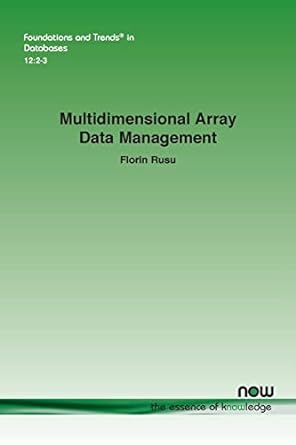Question
Lab - Trace a Route Determine network connectivity to a destination host Trace a route to a remote server using tracert / Scenario Data travels
Lab - Trace a Route
- Determine network connectivity to a destination host
- Trace a route to a remote server using tracert
- / Scenario
Data travels from a source end device to a destination device. Route tracing software lists the path traversed by this data.
This route tracing software is typically executed at the command line as:
tracert
(Microsoft Windows systems)
or
traceroute
(UNIX, Linux systems, and Cisco devices, such as switches and routers)
Both tracert and traceroute determine the route taken by packets across an IP network.
The tracert (or traceroute) tool is often used for network troubleshooting. By showing a list of routers traversed, the user can identify the path taken to reach a particular destination on the network or across internetworks. Each router represents a point where one network connects to another network and through which the data packet was forwarded. The number of routers traversed is known as the number of hops the data traveled from source to destination.
Command-line based route tracing tools are usually embedded with the operating system of the end device. This activity should be performed on a computer that has Internet access and access to a command line.
- Resources
- PC with internet access
- 1: Determine Network Connectivity to a Destination Host.
To trace the route to a distant network, the PC must have a working connection to the internet. Use the ping command to test whether a host is reachable. Packets of information are sent to the remote host with instructions to reply. The PC measures whether each packet receives a response, and how long it takes for those packets to cross the network.
-
-
-
- Navigate to the Command Prompt, enter ping www.cisco.com to determine if it is reachable.
- Now ping one of the Regional Internet Registry (RIR) websites located in different parts of the world to determine if it is reachable:
-
-
Africa: www.afrinic.net
Australia: www.apnic.net
South America: www.lacnic.net
North America: www.arin.net
Note: At the time of writing, the European RIR www.ripe.net does not reply to ICMP echo requests.
The website you selected will be used in next part for use with the tracert command.
-
- 2: Trace a Route to a Remote Server Using Tracert.
After you use ping to determine if your chosen websites are reachable, you will use tracert to determine the path to reach the remote server. Look closely at each network segment that is crossed.
Each hop in the tracert results displays the routes that the packets take when traveling to the final destination. The PC sends three ICMP echo request packets to the remote host. Each router in the path decrements the time to live (TTL) value by 1 before passing it onto the next system. To decrement is to count down. When the decremented TTL value reaches 0, the router sends an ICMP Time Exceeded message back to the source with its IP address and the current time. When the final destination is reached, an ICMP echo reply is sent to the source host.
-
-
- 1: Trace a route to www.cisco.com.
-
At the prompt, trace the route to www.cisco.com.
C:\Users\User1> tracert www.cisco.com
Tracing route to e144.dscb.akamaiedge.net [23.67.208.170]
over a maximum of 30 hops:
1 1 ms <1 ms <1 ms 192.168.1.1
2 14 ms 7 ms 7 ms 10.39.0.1
3 10 ms 8 ms 7 ms 172.21.0.118
4 11 ms 11 ms 11 ms 70.169.73.196
5 10 ms 9 ms 11 ms 70.169.75.157
6 60 ms 49 ms * 68.1.2.109
7 43 ms 39 ms 38 ms Equinix-DFW2.netarch.akamai.com [206.223.118.102]
8 33 ms 35 ms 33 ms a23-67-208-170.deploy.akamaitechnologies.com [23.67.208.170]
Trace complete.
In this example, the source host sends three ICMP echo request packets to the first hop (192.168.1.1) with the TTL value of 1. When the router 192.168.1.1 receives the echo request packets, it decrements the TTL value to 0. The router sends an ICMP Time Exceeded message back to the source. This process continues until the source host sends the last three ICMP echo request packets with TTL values of 8 (hop number 8 in the output above), which is the final destination. After the ICMP echo request packets arrive at the final destination, the router responds to the source with ICMP echo replies.
For hops 2 and 3, these IP addresses are private addresses. These routers are the typical setup for point-of-presence (POP) of ISP. The POP devices connect users to an ISP network.
-
-
- 2: Trace a route to a RIR web site.
- Now perform a tracert to one of RIR web sites from previous part.
- 2: Trace a route to a RIR web site.
-
Africa: www.afrinic.net
Australia: www.apnic.net
South America: www.lacnic.net
North America: www.arin.net
-
-
-
- A web-based whois tool is found at http://whois.domaintools.com/. It can be used to determine the domains traveled from the source to destination.
-
-
Question:
List the domains below from your tracert results using a web-based whois tool, such as http://whois.domaintools.com/.
Type your answers here.
Step by Step Solution
There are 3 Steps involved in it
Step: 1

Get Instant Access to Expert-Tailored Solutions
See step-by-step solutions with expert insights and AI powered tools for academic success
Step: 2

Step: 3

Ace Your Homework with AI
Get the answers you need in no time with our AI-driven, step-by-step assistance
Get Started


